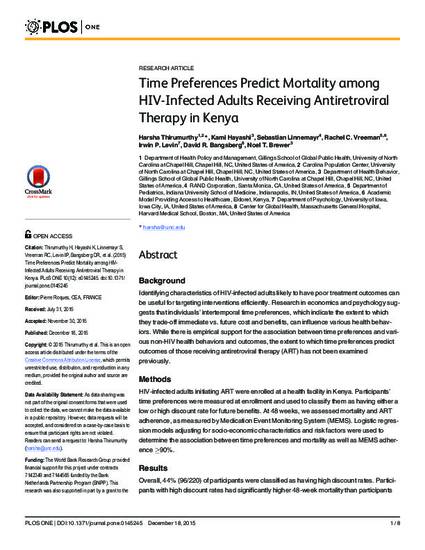
- AIDS (Disease) -- Kenya -- Treatment,
- AIDS (Disease) -- Kenya -- Mortality,
- Antiretroviral therapy
Identifying characteristics of HIV-infected adults likely to have poor treatment outcomes can be useful for targeting interventions efficiently. Research in economics and psychology suggests that individuals’ intertemporal time preferences, which indicate the extent to which they trade-off immediate vs. future cost and benefits, can influence various health behaviors. While there is empirical support for the association between time preferences and various non-HIV health behaviors and outcomes, the extent to which time preferences predict outcomes of those receiving antiretroviral therapy (ART) has not been examined previously.
HIV-infected adults initiating ART were enrolled at a health facility in Kenya. Participants’ time preferences were measured at enrollment and used to classify them as having either a low or high discount rate for future benefits. At 48 weeks, we assessed mortality and ART adherence, as measured by Medication Event Monitoring System (MEMS). Logistic regression models adjusting for socio-economic characteristics and risk factors were used to determine the association between time preferences and mortality as well as MEMS adherence ≥90%.
Overall, 44% (96/220) of participants were classified as having high discount rates. Participants with high discount rates had significantly higher 48-week mortality than participants with low discount rates (9.3% vs. 3.1%; adjusted odds ratio 3.84; 95% CI 1.03, 14.50). MEMS adherence ≥90% was similar for participants with high vs. low discount rates (42.3% vs. 49.6%, AOR 0.70; 95% CI 0.40, 1.25).
High discount rates were associated with significantly higher risk of mortality among HIVinfected patients initiating ART. Greater use of time preference measures may improve identification of patients at risk of poor clinical outcomes. More research is needed to further identify mechanisms of action and also to build upon and test the generalizability of this finding.

At the time of writing, David Bangsberg was affiliated with Harvard Medical School.
Originally appeared in PLoS ONE 10 (12), December 2015.
© 2015 Thirumurthy et al.